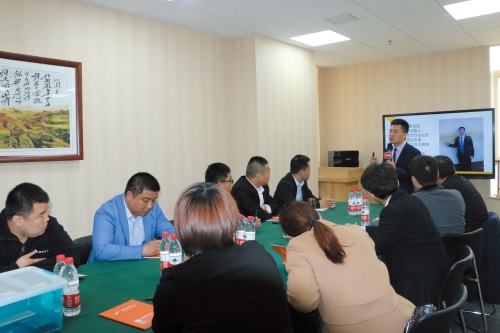

新聞資訊NEWS AND INFORMATION
山東老板必看:股權設計五大雷區,踩中一個就可能讓企業“翻車”!
發布時間:2025-05-22 來源:http://www.lfttpm.com/
在山東這片創業熱土上,每天都有無數企業誕生,但真正能笑到最后的,往往是那些懂得“分蛋糕”藝術的企業家。股權設計不是簡單的數字游戲,而是關乎企業生死存亡的戰略布局。今天,我們就來聊聊山東企業股權設計中最常見的五大誤區,以及如何用“三板斧”破局。
In Shandong, a hotbed of entrepreneurship, countless companies are born every day, but it is often those entrepreneurs who know the art of "dividing the cake" who can truly laugh until the end. Equity design is not a simple numbers game, but a strategic layout that concerns the survival of the enterprise. Today, let's talk about the five most common misconceptions in equity design of Shandong enterprises, and how to use the "three board axe" to break through the situation.
誤區一:股權均分,看似公平實則埋雷
Misconception 1: Equal distribution of equity, seemingly fair but actually sowing a thunderbolt
很多山東老板創業初期喜歡講義氣,兄弟幾個五五分賬,看似公平,實則暗藏危機。比如,兩個創始人各占50%股權,一旦遇到分歧,公司決策直接陷入僵局。更可怕的是,這種“平分”思維會延續到后續融資、人才引進等環節,導致企業股權結構像一盤散沙,經不起風吹草動。
Many Shandong entrepreneurs like to show loyalty in the early stages of their business, dividing the accounts equally among their brothers, which may seem fair, but in reality, there is a hidden crisis. For example, if two founders each hold 50% of the shares, and there is a disagreement, the company's decision-making will be directly deadlocked. What's even more frightening is that this "equal distribution" mentality will continue into subsequent financing, talent introduction, and other links, resulting in the equity structure of the enterprise being like a scattered sand, unable to withstand any changes.
解決方案:
Solution:
“動態股權”打破僵局。山東某生物醫藥企業給出了教科書級示范:他們根據股東貢獻度(資金、技術、資源等)每年調整股權比例,核心高管通過“業績對賭+超額利潤分享”獲得股權增量。這種設計讓團隊凝聚力提升3倍,企業估值三年增長10倍。
Dynamic equity breaks the deadlock. A biopharmaceutical company in Shandong has provided a textbook level demonstration: they adjust their equity ratio annually based on shareholder contributions (funds, technology, resources, etc.), and core executives gain equity increments through "performance betting+excess profit sharing". This design increases team cohesion by three times and increases enterprise valuation by ten times in three years.
誤區二:一股獨大,老板成了“孤家寡人”
Misconception 2: One dominant force makes the boss a 'lone wolf'
有些山東老板信奉“我的地盤我做主”,自己持股超過90%,結果發現團隊積極性低迷,優秀人才留不住。因為員工覺得“反正公司是老板的,干好干壞都一樣”。更危險的是,一旦老板決策失誤,企業可能瞬間崩塌。
Some Shandong bosses believe in "I make my own decisions on my territory" and own more than 90% of the shares, only to find that the team's enthusiasm is low and excellent talents cannot be retained. Because employees feel that 'since the company is owned by the boss, it's the same whether they do it well or badly'. Even more dangerous is that once the boss makes a wrong decision, the company may collapse instantly.
解決方案:
Solution:
“合伙人制度”激活團隊。參考某智能制造企業的做法:將戰略決策權授予7人合伙人委員會,同時設立審計、薪酬、戰略三個專業委員會。這種設計既保持決策效率,又實現專業制衡,企業戰略執行偏差率下降60%。
The 'partnership system' activates the team. Referring to the practice of a certain intelligent manufacturing enterprise: delegate strategic decision-making power to a 7-member partner committee, and establish three professional committees for audit, compensation, and strategy. This design not only maintains decision-making efficiency but also achieves professional checks and balances, reducing the deviation rate of enterprise strategic execution by 60%.
誤區三:資源換股,最后發現“請神容易送神難”
Misconception 3: Resource Swap, Finally Discovering "It's Easy to Ask God, It's Hard to Send God"
山東企業重情義,創業初期常因資金緊張,用高比例股權換取資源支持。但資源方往往只貢獻一次價值,后期卻成了“甩不掉的包袱”。比如,某企業給資源方30%股權,結果對方不參與管理,資源還容易替代,企業后期發展嚴重受限。
Shandong enterprises value loyalty and often use a high proportion of equity to exchange for resource support in the early stages of entrepreneurship due to financial constraints. But resource providers often only contribute value once, and later become an 'inescapable burden'. For example, if a company gives 30% equity to a resource provider, but the other party does not participate in management, the resources are easily replaced, and the company's later development is severely limited.
解決方案:
Solution:
“階梯式資源換股”。可以學習某跨境電商企業的設計:根據資源方貢獻度(如訂單量、客戶數)動態調整股權比例,并設置“對賭條款”——未達目標則股權回購。這種設計既綁定資源,又避免股權過度稀釋。
Step by step resource swap. You can learn from the design of a cross-border e-commerce enterprise: dynamically adjust the equity ratio based on the contribution of resource providers (such as order volume and customer numbers), and set a "bet clause" - if the target is not met, the equity will be repurchased. This design not only binds resources but also avoids excessive dilution of equity.
誤區四:忽視退出機制,股權變成“定時炸彈”
Misconception 4: Neglecting the exit mechanism and turning equity into a "time bomb"
很多山東企業沒有設計股權退出條款,結果小股東“躺平”甚至“搗亂”,大股東卻束手無策。比如,某企業小股東因個人原因退出,但拒絕轉讓股權,導致企業融資受阻。
Many Shandong enterprises have not designed equity exit clauses, resulting in small shareholders lying flat or even causing trouble, while major shareholders are helpless. For example, a small shareholder of a certain enterprise withdrew due to personal reasons but refused to transfer their equity, resulting in obstacles to the company's financing.
解決方案:
Solution:
“階梯式退出條款”。參考某人工智能企業的設計:股東退出時,股權回購價格與公司業績、行業指數、服務年限掛鉤。完成對賭后,原團隊股權可轉換為集團股權。這種設計使并購整合成功率提升至90%。
Step by step exit clause. Referring to the design of an artificial intelligence enterprise: when shareholders exit, the share repurchase price is linked to the company's performance, industry index, and service life. After completing the bet, the original team equity can be converted into group equity. This design increases the success rate of mergers and acquisitions integration to 90%.

誤區五:股權與貢獻脫節,團隊變成“大鍋飯”
Misconception 5: The disconnect between equity and contribution turns the team into a 'big pot of rice'
有些企業股權分配“拍腦袋”,導致貢獻大的員工寒心,混日子的人占便宜。比如,某企業技術骨干持股5%,而財務投資人卻占20%,結果核心團隊集體出走。
Some companies' equity distribution "smashes their heads", causing employees with high contributions to feel disheartened and those who just slack off to take advantage. For example, a company's technical backbone holds 5% of the shares, while financial investors hold 20%, resulting in the core team collectively leaving.
解決方案:
Solution:
“三維評估模型”。山東某消費電子企業采用“戰略重要性+資本投入+業績貢獻”三維模型分配股權。核心高管通過“超額利潤激勵”獲得股權增量,普通員工則通過“虛擬股權”享受分紅。這種設計使團隊效率提升50%。
Three dimensional evaluation model. A consumer electronics company in Shandong adopts a three-dimensional model of "strategic importance+capital investment+performance contribution" to allocate equity. Core executives receive equity increments through "excess profit incentives," while ordinary employees enjoy dividends through "virtual equity. This design increases team efficiency by 50%.
股權設計不是“分蛋糕”,而是“種果樹”
Equity design is not about "dividing the cake", but about "planting fruit trees"
股權設計的核心,是讓企業成為“價值共生體”。山東企業不妨借鑒“動態調整+生態激勵+階梯退出”的三板斧:
The core of equity design is to make the enterprise a 'value symbiosis'. Shandong enterprises may learn from the three pronged approach of "dynamic adjustment+ecological incentives+tiered exit":
動態調整:每年根據股東貢獻重新分配股權,避免“躺贏”;
Dynamic adjustment: Annual redistribution of equity based on shareholder contributions to avoid "lying down wins";
生態激勵:將上下游伙伴納入股權體系,構建產業生態;
Ecological incentives: Incorporate upstream and downstream partners into the equity system and build an industrial ecosystem;
階梯退出:設計靈活退出機制,避免股權僵化。
Ladder exit: Design a flexible exit mechanism to avoid equity rigidity.
記住:好的股權設計,不是讓老板“說了算”,而是讓企業“自己長”。
Remember: a good equity design is not to let the boss "decide", but to let the enterprise "grow on its own".
本文由山東股權設計友情奉獻.更多有關的知識請點擊:http://www.lfttpm.com真誠的態度.為您提供為全面的服務.更多有關的知識我們將會陸續向大家奉獻.敬請期待.
This article is about Shandong Equity Incentive Friendship Dedication For more information, please click: http://www.lfttpm.com Sincere attitude To provide you with comprehensive services We will gradually contribute more relevant knowledge to everyone Coming soon.
本站聲明
本網站為非營利性網站,旨在宣揚股權知識,交流職業學習心得。網站內部分文章來自其它網站,只做交流學習之用。相應的權力均屬于原權 力人,如權利人認為不妥,請來電來函說明,本網站隨既停止或使用,謝謝合作! 13698613138
13698613138
微信公眾號

掃碼獲知更多知識

抖音二維碼

截屏,微信識別二維碼